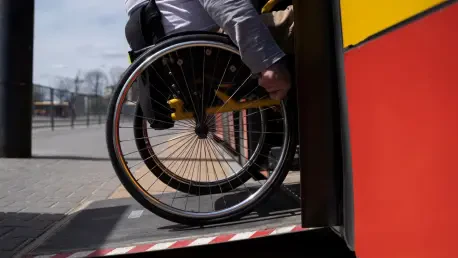Imagine a bustling city street corner where a person in a wheelchair approaches, only to find a steep, crumbling curb with no ramp in sight, turning a routine trip into an impossible challenge. This barrier highlights a pervasive issue in urban areas across the United States, where thousands of curb ramps—essential for accessibility—are either outdated, damaged, or entirely absent, leaving many residents stranded at the edge of sidewalks. Technology, however, is stepping in as a game-changer, with cities harnessing innovative tools to map, assess, and upgrade these critical pathways to meet standards set by the Americans with Disabilities Act (ADA).
The importance of this issue cannot be overstated. Curb ramps are more than just infrastructure; they represent equity and inclusion for individuals with disabilities, ensuring safe navigation in public spaces. With aging urban systems and incomplete records plaguing many municipalities, the push to address these gaps has gained urgency. Cities like Douglas County, Nebraska, and Lawrence, Kansas, are leading the charge by adopting advanced solutions such as Geographic Information Systems (GIS), GeoAI, and LiDAR, setting a precedent for how technology can transform accessibility challenges into actionable progress.
Why Curb Ramps Are Grabbing Attention Now
In many urban centers, the state of curb ramps has quietly reached a crisis point. These small but vital structures, meant to bridge sidewalks and streets, often fail to meet modern accessibility standards, creating daily obstacles for those with mobility impairments. A single missing or non-compliant ramp can derail an entire journey, forcing individuals to take lengthy detours or risk dangerous alternatives. This growing awareness of the human toll has pushed local governments to prioritize solutions with a sense of urgency.
What’s driving this sudden focus? Legal mandates under the ADA require cities to ensure accessible infrastructure, yet compliance has lagged due to decades of neglect and poor documentation. The scale of the problem is staggering, with some cities discovering that a majority of their ramps need repair or installation. As public demand for equitable access rises, municipalities are turning to technology to close these gaps efficiently, spotlighting an issue that has long been overlooked.
The ADA Struggle with Urban Accessibility Gaps
Compliance with the ADA is not just a legal obligation; it’s a cornerstone of creating inclusive communities. The law mandates that curb ramps be installed or upgraded to specific standards whenever roads are built or altered, yet many cities grapple with incomplete inventories of their infrastructure. Without accurate data on the location or condition of ramps, planning for repairs becomes a guessing game, leaving countless barriers unaddressed.
Statistics paint a sobering picture of the challenge. In Lawrence, Kansas, a recent assessment revealed that 70% of sidewalks and curb ramps require significant repair or reconstruction, reflecting a broader trend of deteriorating urban systems nationwide. Aging infrastructure, combined with budget constraints and historical oversight, has created a backlog of accessibility issues, amplifying the need for systematic approaches to tackle this widespread problem.
Tech-Driven Tools Revolutionizing Compliance Efforts
Enter the era of tech-powered solutions, where cities are leveraging cutting-edge tools to overhaul curb ramp management. In Douglas County, Nebraska, which includes Omaha, officials have used GeoAI and GIS technology to map over 34,000 curb ramps in a mere 12 days—a task that would have taken six months of manual labor. This rapid data collection marks a seismic shift from outdated methods to precise, scalable systems.
Meanwhile, Lawrence, Kansas, has adopted LiDAR technology alongside GIS to evaluate nearly 6,600 ramps, capturing detailed metrics on slope angles and physical obstructions. This granular data allows for accurate assessments of compliance, eliminating guesswork. By transitioning to data-driven strategies, these cities are not only identifying problem areas but also laying the groundwork for efficient, targeted upgrades that redefine infrastructure management.
The impact of these technologies extends beyond speed. They enable municipalities to allocate resources effectively, focusing on high-priority fixes rather than scattered, reactive repairs. This shift to a proactive stance is setting a new benchmark for how urban accessibility challenges can be addressed, proving that innovation can bridge long-standing gaps in compliance.
Perspectives from the Ground on Tech’s Real Impact
Hearing from those directly involved brings depth to the story of tech’s role in accessibility. Steve Cacioppo, a GIS analyst in Douglas County, described the meticulous process of training GeoAI models to ensure accuracy, even in older urban areas with inconsistent layouts. “It’s not perfect—sometimes it picks up a sunroof instead of a ramp—but the ability to correct errors quickly is invaluable,” he noted, highlighting the adaptability of these tools.
In Omaha, Todd Spark from Public Works expressed astonishment at the sheer volume of undocumented ramps uncovered through the technology. “The numbers blew us away. We had no idea how much was out there,” he admitted, underscoring how digital mapping reveals hidden challenges. Over in Lawrence, Evan Korynta, the ADA compliance administrator, emphasized prioritizing high-need zones, saying, “Data lets us focus on areas with the most pedestrian demand first.” Adding to this, Jessica Mortinger, a transportation planning manager, shared a vision for public dashboards to display progress, noting, “Transparency builds trust and shows why this investment matters.” These voices collectively illustrate a blend of technical innovation and human commitment driving change.
Practical Steps for Cities to Embrace Tech Solutions
For municipalities eager to replicate these successes, a clear roadmap emerges from the experiences of Douglas County and Lawrence. The first step involves investing in GIS and LiDAR technologies to create a comprehensive curb ramp inventory, providing a detailed baseline for action. This foundational data collection, as demonstrated in Nebraska, can drastically cut down on time and labor.
Next, cities should establish a prioritization framework, similar to Lawrence’s 1-to-10 rating system, which targets high-demand and underserved areas for immediate upgrades. Following this, a shift to a corridor-based repair approach—focusing on entire blocks rather than isolated fixes—ensures holistic improvements. Finally, engaging communities through transparent tools like live progress maps can sustain public support and secure funding, making these tech-driven initiatives viable for the long term. This structured path offers a blueprint for turning accessibility goals into reality.
Reflecting on a Path Forward
Looking back, the journey of cities like Douglas County and Lawrence showcased how technology reshaped the landscape of ADA compliance for curb ramps. Their adoption of GIS, GeoAI, and LiDAR turned invisible barriers into visible, solvable problems, paving the way for safer, more inclusive streets. The dedication of local officials and the power of data-driven strategies stood as testaments to what focused innovation could achieve.
Moving ahead, other municipalities can draw inspiration from these efforts by starting with small-scale tech pilots to assess their own infrastructure gaps. Collaborating with disability advocacy groups to refine prioritization criteria ensures that upgrades meet real community needs. Additionally, securing federal or state grants for accessibility projects can ease financial burdens, allowing more cities to embark on this transformative work. These steps, built on the foundation laid by early adopters, point toward a future where no street corner remains an insurmountable obstacle.









